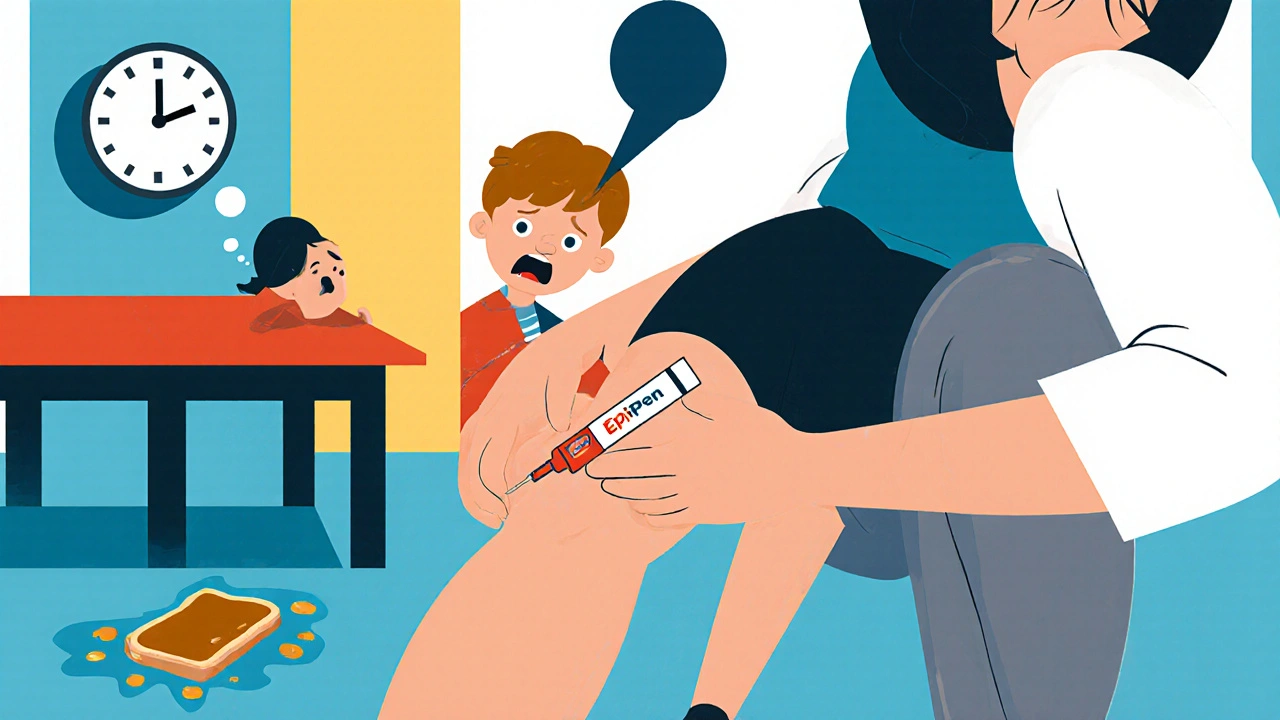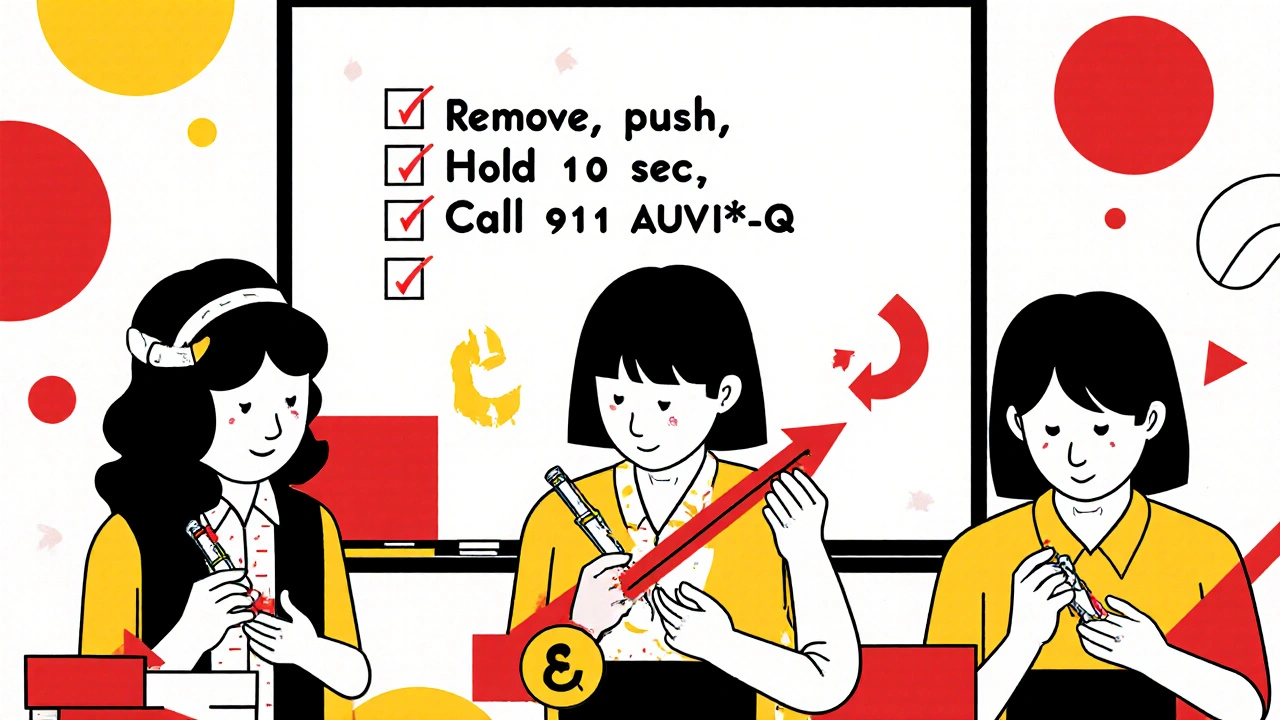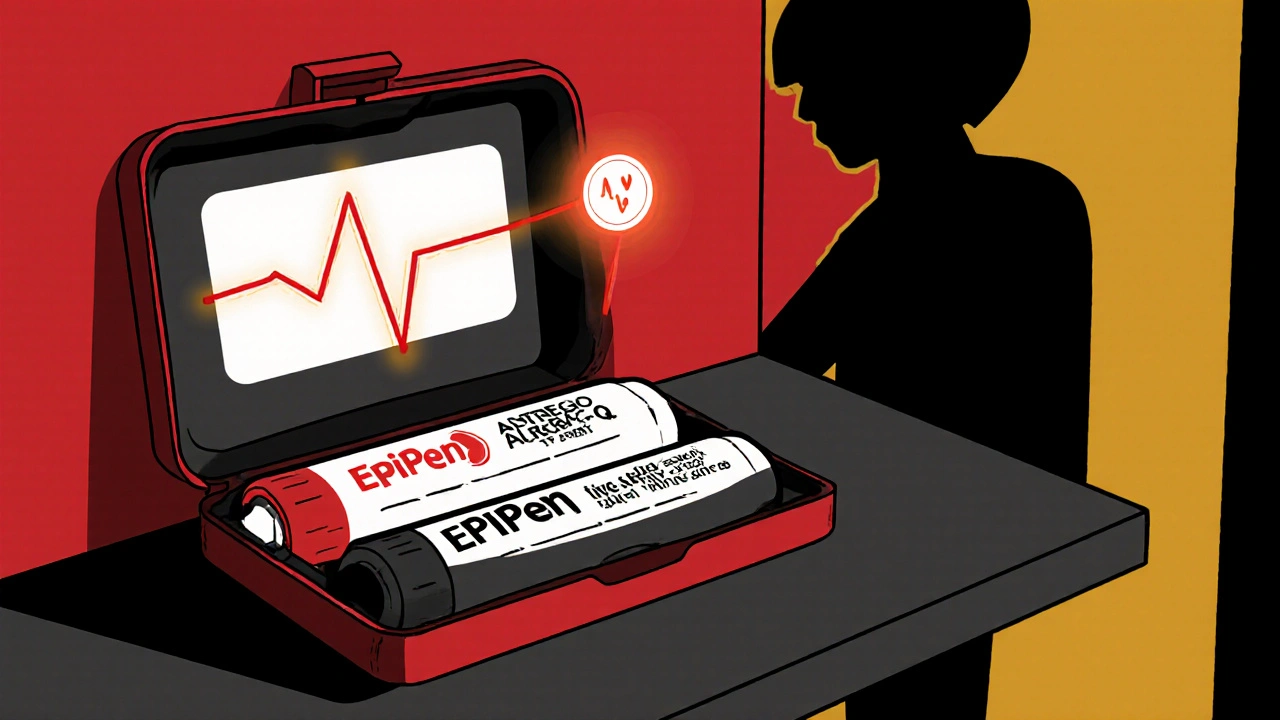Epinephrine Auto-Injector Training: How to Prevent Mistakes and Save Lives
 Nov, 20 2025
Nov, 20 2025
Epinephrine Auto-Injector Technique Checker
Check Your Injection Technique
This tool verifies if you're following correct epinephrine auto-injector administration procedures based on medical guidelines. Enter your steps below.
Why Epinephrine Training Isn’t Just a Formality
It’s 10:15 a.m. in a busy elementary school cafeteria. A child starts coughing, their face turns red, and their lips swell. A teacher grabs the EpiPen from the emergency kit. But instead of injecting into the outer thigh, they hesitate-was that just a rash? Did they remember which end to press? The clock ticks. Five minutes pass. Ten. By the time help arrives, it’s too late.
This isn’t fiction. It’s a real pattern. According to the epinephrine auto-injector guidelines from the American Academy of Allergy, Asthma & Immunology, 95% of deaths from anaphylaxis happen within 48 hours of symptom onset-and most occur because epinephrine was given too late or not at all. The problem isn’t lack of devices. It’s lack of correct training.
Every state in the U.S. now allows schools to keep stock epinephrine. Thirty-eight states, including California, Illinois, and Ohio, require formal training for staff who might need to use it. But here’s the gap: only 22% of school districts hold mandatory refresher courses every year. Skills fade fast. After six months without practice, retention drops to 47%. That means nearly half of the people trained to save a life can’t do it when it counts.
What Happens When You Get the Injection Wrong
It’s not just about speed. Technique matters just as much. A 2020 University of Michigan study found that untrained people take over two minutes to correctly use an auto-injector during their first attempt. After three practice sessions with trainer devices, that drops to 48 seconds. That’s a 70% improvement-and it’s the difference between life and death.
Common mistakes? They’re more frequent than you think:
- 43% fail to remove the safety cap properly-some pull the wrong end, others don’t pull hard enough.
- 29% inject into the front of the thigh instead of the outer side, where the muscle is thickest and blood flow is fastest.
- 18% don’t hold the device in place long enough. Some think one second is enough. AUVI-Q requires 10 seconds. EpiPen requires 2. Get it wrong, and you don’t deliver the full dose.
And then there’s the clothing issue. A school nurse on Reddit shared how a teacher tried to inject through jeans during a drill. The needle can’t penetrate thick fabric. You need bare skin. That’s not a suggestion-it’s a requirement.
Even the device orientation matters. AUVI-Q must be held with the blue cap up and the green needle end down. Flip it, and you’ll accidentally activate the needle before you’re ready. Many training kits use generic trainers that don’t match real devices. That’s why some staff get confused during real emergencies. If your school uses EpiPens, train on EpiPens-not a generic model.
Recognizing the Difference Between Mild and Severe
One of the biggest reasons epinephrine is delayed? Misreading the symptoms. A runny nose or a few hives might seem like a "mild reaction." But anaphylaxis doesn’t always start with swelling. It can start with stomach pain, vomiting, or a feeling of doom. The key is progression.
California’s training standards require staff to learn how to distinguish between mild and severe reactions. Mild might be isolated hives or itching. Severe means two or more body systems are involved-skin and breathing, or skin and stomach. Or, if there’s any sign of trouble breathing, dizziness, or fainting, it’s severe. No hesitation.
Dr. Robert Wood from Johns Hopkins says up to 83% of fatal cases involve failure to give epinephrine at the first sign of a reaction. Why? Because people think, "Maybe it’ll get better." Or, "I don’t want to overreact." But in anaphylaxis, waiting is the biggest risk. Epinephrine is safe. The reaction isn’t.
Why Two Injectors Are Non-Negotiable
One auto-injector isn’t enough. Studies show 16% to 35% of anaphylaxis cases require a second dose. Why? Because the first dose wears off, or the reaction comes back stronger-called a biphasic reaction. This can happen hours later.
Food Allergy Research & Education (FARE) says: "Having two auto-injectors on hand is necessary." That’s not a recommendation. It’s a standard. Yet many schools only stock one per campus. Some parents only carry one for their child. That’s dangerous.
Here’s the reality: if the first injector fails to deploy, or if the person is too small for the 0.3 mg dose and needs the pediatric version, you need a backup. And if paramedics are delayed? You need a second dose within five minutes. No exceptions.

Training That Actually Works
Lectures don’t work. Videos alone don’t work. You need hands-on practice.
A 2022 study in the Journal of School Nursing found that training programs with hands-on practice using trainer devices reduced administration errors by 78%. Those that included symptom recognition drills cut decision-making time by 3.2 minutes on average.
What does effective training look like?
- Use real device models (EpiPen, Auvi-Q, Adrenaclick)-not generic ones.
- Practice on mannequins or each other’s thighs (with trainer pens).
- Run mock scenarios: "Child collapses after eating peanut butter. What do you do?"
- Include a competency check: Can they name the injection site? Can they explain when to give a second dose?
Ohio’s OhioTRAIN program requires a 45-minute session with video, a 15-question test (80% pass rate), and a skills evaluation. California requires written materials to be kept for three years and mandates observation of shock signs-like covering the person with a blanket to prevent hypothermia. Illinois requires a formal competency test. These aren’t bureaucratic hoops. They’re lifesavers.
What Happens After You Inject
Injecting epinephrine isn’t the end. It’s the beginning.
After giving the shot:
- Call 911 immediately-even if the person seems better.
- Have them lie flat with legs elevated (unless they’re vomiting or having trouble breathing).
- Keep them warm. Cover with a blanket. Shock can set in even after epinephrine.
- Monitor breathing, pulse, and consciousness every five minutes.
- Be ready to give a second dose if symptoms return or worsen after five minutes-and paramedics haven’t arrived.
Epinephrine works fast, but it doesn’t last long. The reaction can come back. That’s why emergency services must be called every single time-even if the person says they’re fine.
Overcoming Fear and Legal Myths
One of the most surprising barriers? Fear of getting sued.
A 2022 survey of 2,147 school nurses found that 42% worried about legal consequences if they gave epinephrine "wrong." But here’s the truth: all 50 states have Good Samaritan laws protecting anyone who acts in good faith during an emergency. No one has ever been successfully sued for giving epinephrine in a school setting.
More often, the fear comes from uncertainty. "What if I’m wrong?" But the data says: being wrong about giving epinephrine is far safer than being wrong about not giving it.
One Texas school nurse put it this way: "We’ve had two real incidents this year. Both times, the staff administered correctly. Both kids are alive. That’s because we practiced every quarter with expired pens. We didn’t wait for the crisis to learn."

The Future of Training: VR and Automation
Some schools are moving beyond paper handouts and videos. The American Red Cross launched a virtual reality training module in April 2023. In a pilot with 450 staff, it cut training time by 35% and improved skill retention by 28% after six months.
Ohio is piloting systems where training records sync with school health databases. If someone’s training expires, the system flags it. If an injector is missing or expired, it sends an alert. In 12 counties, this reduced expired or missing devices by 94%.
These aren’t futuristic ideas. They’re necessary. Rural districts struggle with staff turnover. One in three can’t keep trained personnel. Automated reminders and digital training help close that gap.
What You Need to Do Today
If you’re a school administrator, parent, or staff member-here’s your checklist:
- Confirm your school has two epinephrine auto-injectors available at all times.
- Ask: Are staff trained on the exact device we keep? (Not a generic one.)
- Request a hands-on practice session every three months-not once a year.
- Make sure everyone knows the injection site: outer thigh, bare skin.
- Review the signs of severe anaphylaxis: two or more body systems affected.
- Ensure every trained person knows: after injection, call 911, monitor, and be ready for a second dose.
Anaphylaxis doesn’t wait for perfect conditions. It doesn’t care if it’s a busy morning or if the person is tired. It only cares if someone acts-fast and right.
Training isn’t about compliance. It’s about courage. And the only way to build that courage is through practice, repetition, and clarity.
What happens if I inject epinephrine into the wrong spot?
Injecting into the front of the thigh or through clothing can delay absorption and reduce effectiveness. The outer thigh is the only recommended site because it has thick muscle and good blood flow. If you accidentally inject elsewhere, still give the shot-don’t waste time correcting it. Call 911 immediately and prepare for a second dose if needed.
Can I use an expired epinephrine auto-injector?
Yes, if it’s the only option during an emergency. Epinephrine degrades slowly, and even expired devices often retain some potency. The risk of not using it is far greater than the risk of using an expired one. Replace it as soon as possible after the event.
Do I need to remove the safety cap before injecting?
Yes, always. Each device has a specific sequence: for EpiPen, pull the blue cap off first. For AUVI-Q, remove the green needle protector first, then the blue safety cap. Never assume-read the label on your specific device. Practice with trainer pens so the steps become automatic.
How do I know when to give a second dose?
Give a second dose if symptoms continue or worsen after five minutes and emergency help hasn’t arrived. Signs include: worsening breathing, new swelling, dizziness, or loss of consciousness. Don’t wait for the person to collapse. If you’re unsure, give it. Epinephrine is safe to repeat.
Is it safe for someone without training to use an epinephrine auto-injector?
Yes. Auto-injectors are designed for non-medical users. The instructions are simple: remove cap, place against thigh, push firmly until you hear a click, hold for 10 seconds (or as directed). Even if you’ve never seen one before, following the steps on the device can save a life. Don’t let lack of training stop you from acting.
Final Thought: Training Is the Shield
Epinephrine auto-injectors are powerful tools. But they’re useless without people who know how to use them. The best device in the world won’t help if the person holding it is frozen with doubt.
Training isn’t about checking a box. It’s about building muscle memory, confidence, and clarity. Every practice session, every drill, every minute spent learning the difference between a rash and a reaction-those minutes are the shield between a child and tragedy.
Don’t wait for a crisis to start. Start today.

Debanjan Banerjee
November 21, 2025 AT 18:49Just finished training our entire staff on EpiPens using real devices-not the generic ones. We did mock drills every week for a month. The difference? From 47% retention to 92% after three months. No more hesitation. No more fumbling. If you’re not practicing like this, you’re gambling with lives.
Steve Harris
November 22, 2025 AT 18:58This is the most important thing I’ve read all year. I work in a rural school district where we only had one EpiPen for 800 kids. We just ordered two per classroom. Also started monthly 10-minute drills during staff meetings. It’s not extra work-it’s survival.
Elaina Cronin
November 23, 2025 AT 16:37The notion that ‘maybe it’ll get better’ is not just dangerous-it’s criminal negligence. Anaphylaxis does not negotiate. Epinephrine is not a suggestion. It is the only intervention that alters mortality. The fact that schools still treat this as optional training reveals a systemic failure in prioritizing child safety.
Willie Doherty
November 25, 2025 AT 14:50Let’s be honest: most of these training programs are performative. They check the box, hand out a PDF, and call it done. The 78% error reduction from hands-on practice? That’s the only metric that matters. Everything else is theater. And theater gets children killed.
Darragh McNulty
November 26, 2025 AT 15:33My niece had a reaction last year-teacher used the EpiPen right away. She’s alive today because they practiced with expired pens every quarter 😊👏. Seriously, if your school doesn’t do this, you’re failing them. Do it. Now.
Chris Vere
November 28, 2025 AT 07:47People forget that epinephrine isn't magic it's just a tool like a fire extinguisher. You don't wait for the fire to spread before learning how to use it. Training is just basic responsibility. Why do we make it so complicated
Pravin Manani
November 28, 2025 AT 12:43The biphasic reaction data is underdiscussed. The 16–35% recurrence rate isn’t theoretical-it’s epidemiologically validated. Without a second auto-injector on-site, you’re operating under a false assumption of efficacy. This isn’t just about training-it’s about supply chain logistics in public health infrastructure.
Leo Tamisch
November 30, 2025 AT 08:48Wow, another ‘epinephrine is life-saving’ op-ed. Did you also mention that breathing is important? Maybe we should all just stop eating peanuts and call it a day. I mean, why train people when we could just ban all allergens? 😏
Franck Emma
November 30, 2025 AT 12:37My kid almost died. The teacher used the EpiPen… but on the wrong leg. She held it for 1 second. We got lucky. The paramedics got there in 4 minutes. Don’t let your school be the next headline.
Paula Jane Butterfield
December 2, 2025 AT 11:07My cousin is a nurse in Texas and she said they use expired pens for practice because it’s cheaper and the kids still get the feel of the click. She says it’s better than nothing and the staff aren’t scared to use it anymore. Also… I think you meant ‘bare skin’ not ‘bare skin’ 😅
Florian Moser
December 2, 2025 AT 12:09Every teacher should have to do this drill before school starts. No exceptions. No paperwork. Just hands-on, real-time, muscle-memory training. If you can’t do it blindfolded, you’re not ready. And if your district won’t do it? Push harder. This isn’t optional.
Julia Strothers
December 2, 2025 AT 21:28Who’s funding these ‘VR training modules’? Big Pharma? The EpiPen makers? They’re pushing this because they make billions off expired devices. And now they want schools to buy new ones every year? Wake up. This is a profit scheme disguised as safety.
David vaughan
December 2, 2025 AT 23:44I’m a school nurse. We trained everyone. We use real devices. We do drills. We have two injectors per classroom. We track expiration dates. We log everything. We’ve had three real reactions this year. All kids survived. No lawsuits. No panic. Just preparation. Don’t wait for tragedy to act. Do it. Now. Please.